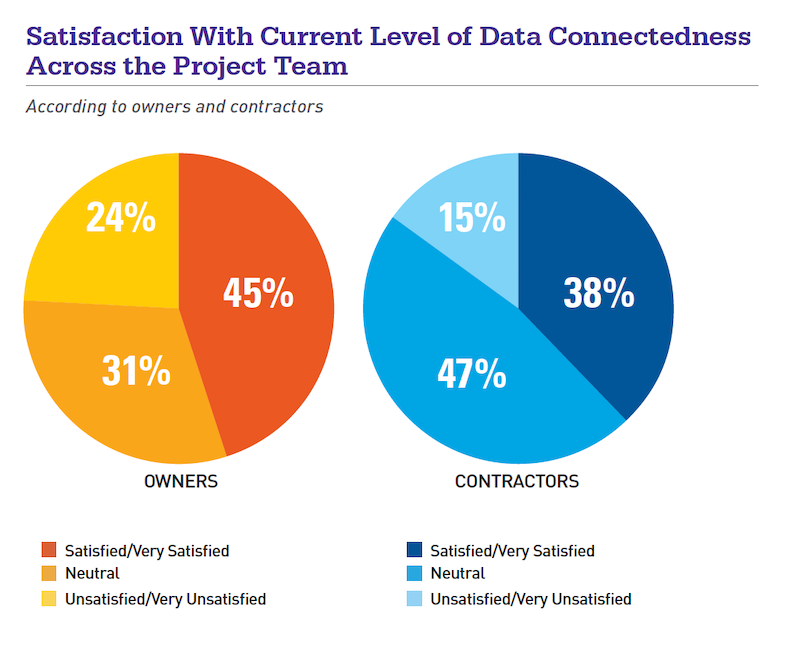A new survey of building owners and contractors highlights the challenges of managing construction projects when software applications lack automated data exchange processes.
The report, “Connecting Owners and Contractors: How Technology Drives Connected Construction,” was released by e-Builder, a Trimble Company, and Dodge Data & Analytics. It is based on responses to online surveys last Spring from 112 contracting companies and 98 building owners. Nearly three-quarters of the contractor respondents identify themselves as GCs. Sixty-nine percent of the owners operate within the public sector, and most focus on education, government, or healthcare projects.
Among these companies, 57% of owners and 52% of contractors say they use Project Management Information Systems (PMIS). However, these systems often are not compatible: only 16% of contractors say that an owner’s PMIS is the same as their own, and only 14% say they can integrate the two systems. But owners appear to have the upper hand here, as seven out of 10 owner-respondents with PMIS require contractors to use the owner’s system. More than half of these owners deploy their systems on more than half of their projects.
Consequently, about two-fifths of contractors say they end up using the owners’ systems and their own, leading to double data entry that, the survey found, has a negative impact on worker productivity, workflow, accuracy, decision making, and scheduling.

The survey finds that most owners insist that their PMIS prevail as the system used. That demand can present more work for contractors that also prefer to use their own systems.
More than one-third of contractors say they use the owner’s PMIS exclusively. The risk for contractors that use an owner’s PMIS, according to the survey, include increased costs, lack of proper documentation in the event of a claim, lack of project performance data and reports.
The disconnect, however, is that contractors see all these risks as being much bigger problems than owners do. Only two fifths of contractors are satisfied with the status quo, compared to nearly three fifths of owners. Contractors, though, also tend to be more neutral than owners about these systems’ incompatibilities, apparently accepting inefficiencies as part of doing business.
The irony is that there’s consensus among contractors and owners about, and a high level of satisfaction with, the overall benefits of using PMIS to handle such things as submittals and RFIs. Sixty-five percent of owners and 51% of contractors see high/very high value in a single platform that all parties use on projects for data management. “Both believe that creating a more seamless workflow for their processes would increase the value they receive,” the report states.

Contractors and owners agree that there's value in managing projects using a single, seamless system.
The report quotes Aaron Haas, Executive Vice President and construction manager with Howard Hughes, that within such a seamless scenario “there should be no miscommunication about cost, change orders, RFIs, submittals; it’s all one unified system.” Contractors in general believe that the key to accelerating this project process, and to getting paid quicker, is better data exchange.
But the industry has a ways to go to reach that plateau. The survey finds that 73% of contractors still use manual methods to measure project progress on more than half of their jobs, and 49% of pros subjectively estimate project progress on more than half of their jobs.
\More than a quarter of contractors don’t use a PMIS because they think it’s too expensive, and 23% think it’s too complicated. But 58% expressed a moderate to higher interest in using a system within the next three years.
Related Stories
| Jun 13, 2017
Accelerate Live! talk: A case for Big Data in construction, Graham Cranston, Simpson Gumpertz & Heger
Graham Cranston shares SGH’s efforts to take hold of its project data using mathematical optimization techniques and information-rich interactive visual graphics.
| Jun 13, 2017
Accelerate Live! talk: Scaling change in a changing industry, Chris Mayer, Suffolk Construction
Suffolk’s CIO Chris Mayer talks about the firm’s framework for vetting and implementing new technologies and processes.
| Jun 13, 2017
Accelerate Live! talk: Gaming tech in construction, Lucas Richmond, Gilbane
Learn why Gilbane’s Lucas Richmond is looking outside the AEC industry to build his rockstar gaming and media team.
| Jun 12, 2017
Accelerate Live! talk: The world's smartest buildings, Derik Eckhardt, Miller Hull Partnership
Discover what architect Derik Eckhardt learned during his worldwide tour of the globe’s smartest buildings, from Abu Dhabi to Amsterdam to Stuttgart to Dubai.
| Jun 12, 2017
Accelerate Live! talk: Preparing for the AI revolution, Alan Robles, Gensler
Gensler’s Alan Robles shares how the AEC Giant firm is preparing its project teams and clients for the coming artificial intelligence movement.
| May 24, 2017
Accelerate Live! talk: Applying machine learning to building design, Daniel Davis, WeWork
Daniel Davis offers a glimpse into the world at WeWork, and how his team is rethinking workplace design with the help of machine learning tools.
| May 24, 2017
Accelerate Live! talk: Learning from Silicon Valley - Using SaaS to automate AEC, Sean Parham, Aditazz
Sean Parham shares how Aditazz is shaking up the traditional design and construction approaches by applying lessons from the tech world.
| May 24, 2017
Accelerate Live! talk: The data-driven future for AEC, Nathan Miller, Proving Ground
In this 15-minute talk at BD+C’s Accelerate Live! (May 11, 2017, Chicago), Nathan Miller presents his vision of a data-driven future for the business of design.
AEC Tech | May 23, 2017
A funny thing may happen on the way to AI
As AI proves safe, big business will want to reduce overhead.
AEC Tech | May 11, 2017
Accelerate Live!: Social media reactions from BD+C's AEC innovation conference
BD+C's inaugural Accelerate Live! innovation conference took place May 11, in Chicago.









